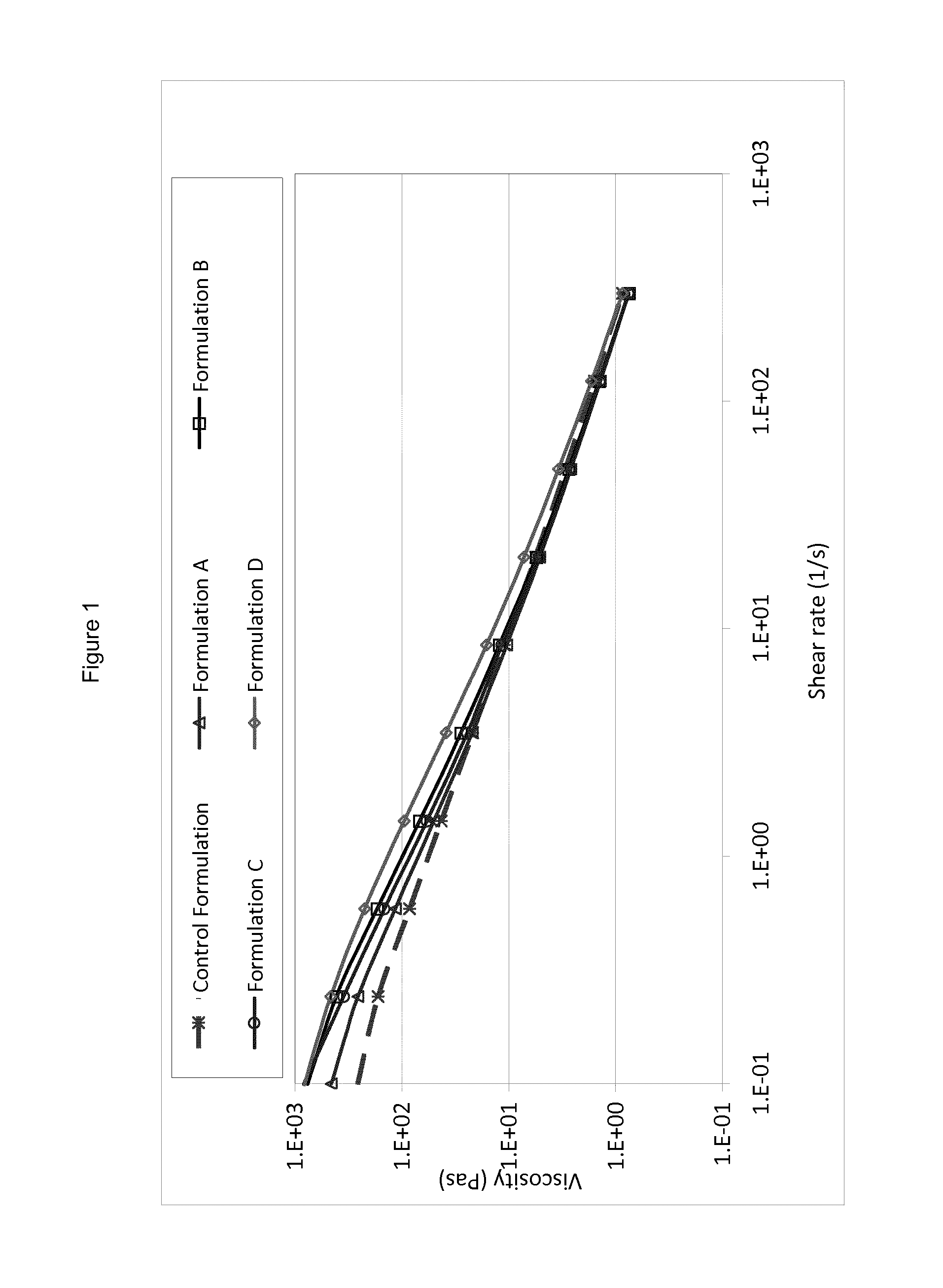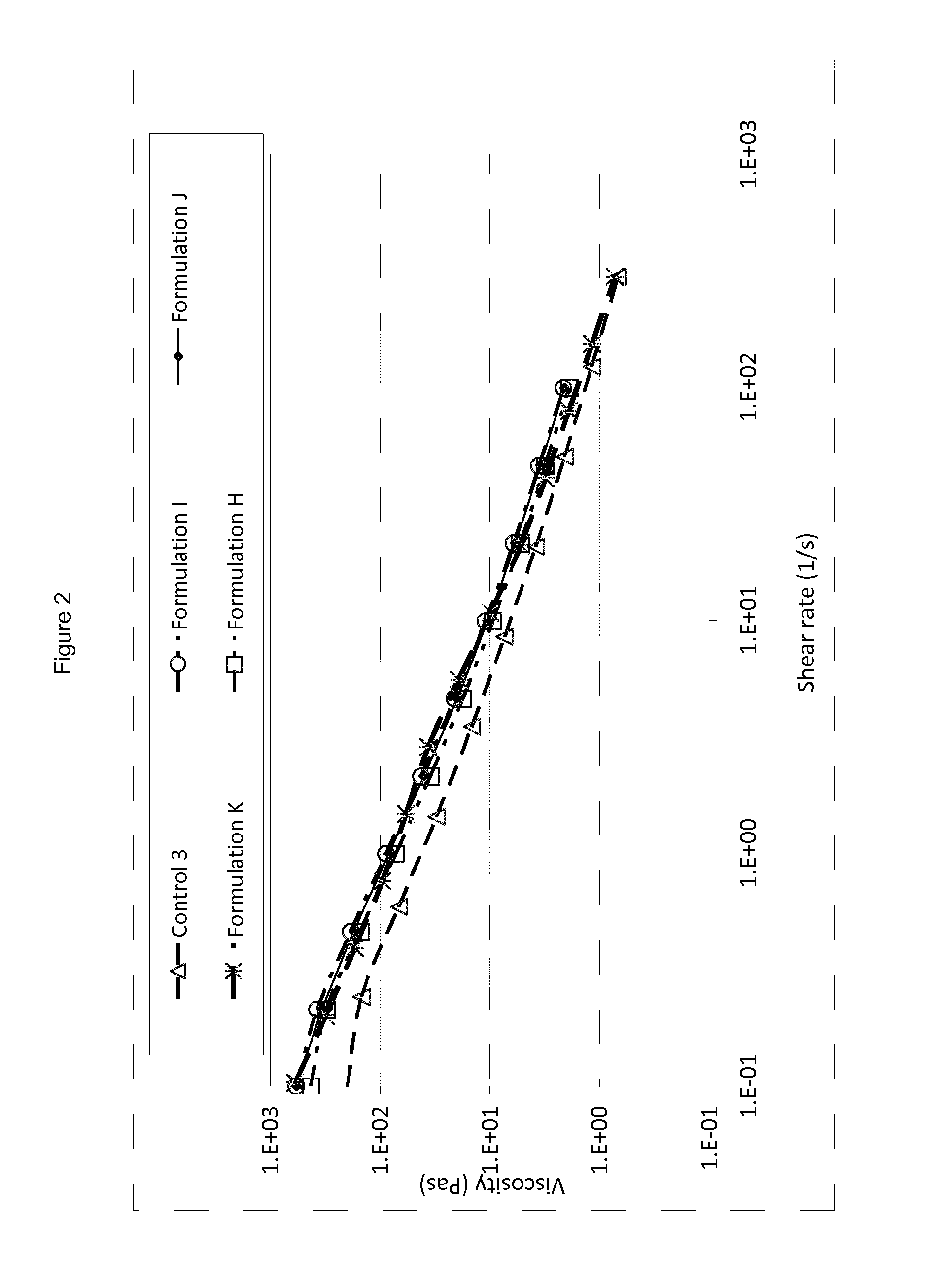Compositions for paint
a technology of compositions and paints, applied in the field of compositions of paints, can solve the problem of inherently expensive paint components
- Summary
- Abstract
- Description
- Claims
- Application Information
AI Technical Summary
Benefits of technology
Problems solved by technology
Method used
Image
Examples
example 1
[0156]A series of paint formulations were mixed under high shear in which the standard hydroxyethyl cellulose component was progressively replaced by microfibrillated cellulose. Details of the formulations are shown in Table 1. The microfibrillated cellulose (MFC) sample was made by co-grinding a ground calcium carbonate having a d50 of 1.4 μm with Botnia northerned bleached sulphate pulp in a stirred media mill at a specific energy of 2500 kWh / tonne of pulp. The MFC used in the paint formulation was provided in the form of an aqueous slurry comprising 2% by weight microfibrillated cellulose and 8% by weight ground calcium carbonate.
[0157]FIG. 1 shows the rheology profiles (viscosity as a function of shear rate) of the formulations used. Replacement of the hydroxyethyl cellulose rheology modifier with microfibrillated cellulose prepared in accordance with the methods described herein maintains the paint viscosity at high shear rate approximately constant, but significantly increases...
example 2
[0159]A second series of paint formulations, this time with a portion of the talc replaced with a coarse calcium carbonate (having a d50 of 6.5 μm, were mixed under high shear in which the standard hydroxyethyl cellulose component was progressively replaced by microfibrillated cellulose. Details of the formulations are shown in Table 3, and properties of the paint films in Tables 4a and 4b.
[0160]The mud cracking propensity of these paints was assessed by the drawdown of films which increase in thickness across their width, and recording of the film thickness in microns at which cracking after drying first appears. The higher the thickness at which cracking is observed, the lower is the tendency of the paint to give cracking problems in use.
[0161]Mud cracking was determined in the following manner:
Materials and Apparatus:
[0162]Substrate: gypsum plasterboard[0163]Wedge applicator (300 to 1500 μm wet film thickness)[0164]Series of bar applicators (1500, 1750, 2000, 2250 and 2500 μm wet...
example 3
[0196]The sample of microfibrillated cellulose from Example 1 was diluted to 2.5 wt % total solids and passed once through a GEA Niro Soavi homogeniser (model: Pony NS2006L) at 500 bar pressure. The product from the homogenizer was then concentrated back to 10% solids (2% microfibrillated cellulose) by centrifuge and used progressively to substitute hydroxyethyl cellulose in the equivalent formulation as used in Example 2. Formulation details are provided in Table 5.
[0197]The optical properties of the paint films made from these formulations are summarized in Table 6. As can be seen, the further treatment leads to a greater enhancement of the light scattering and, thus, opacity of the paint. Rheology profiles are shown in FIG. 2—again the microfibrillated cellulose enhances the viscosity of the formulation at low shear.
TABLE 5Con-Formu-Formu-Formu-Formu-trollationlationlationlation3HIJKRutile pigment coated1010101010with alumina (TiO2content - 94%)Refined kaolin having a1010101010d5...
PUM
| Property | Measurement | Unit |
|---|---|---|
| Fraction | aaaaa | aaaaa |
| Percent by mass | aaaaa | aaaaa |
| Angle | aaaaa | aaaaa |
Abstract
Description
Claims
Application Information
 Login to View More
Login to View More - R&D
- Intellectual Property
- Life Sciences
- Materials
- Tech Scout
- Unparalleled Data Quality
- Higher Quality Content
- 60% Fewer Hallucinations
Browse by: Latest US Patents, China's latest patents, Technical Efficacy Thesaurus, Application Domain, Technology Topic, Popular Technical Reports.
© 2025 PatSnap. All rights reserved.Legal|Privacy policy|Modern Slavery Act Transparency Statement|Sitemap|About US| Contact US: help@patsnap.com


